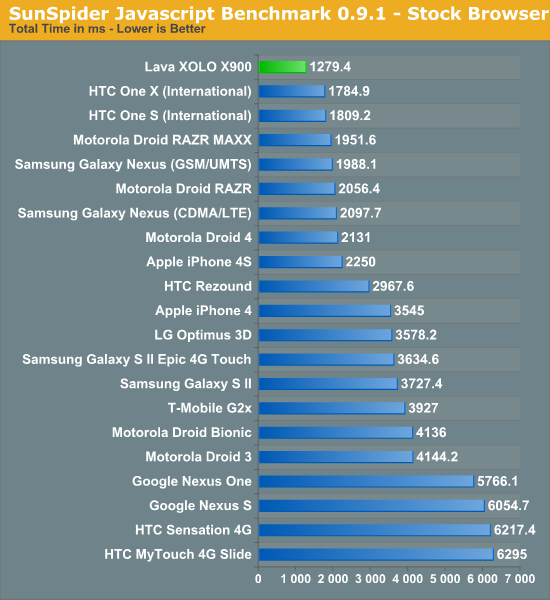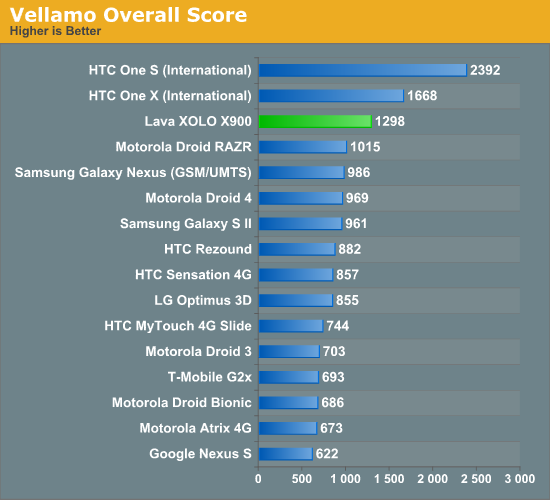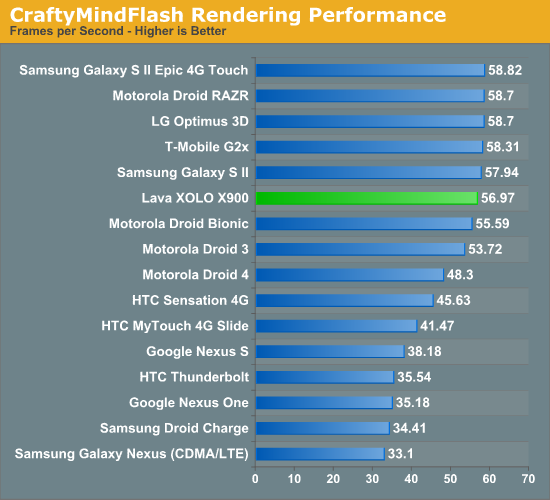Lava Xolo X900 Review - The First Intel Medfield Phone
by Brian Klug on April 25, 2012 6:00 AM ESTJavascript Performance
Although smartphones are clearly headed for a life beyond simple messaging, web browsing and phone duties, we are still lacking the tools to measure performance in areas other than a component of web page rendering. Measuring javascript performance is one component of the entire web page rendering process but it's the most mature in terms of something we can benchmark.
Sunspider is quite possibly the most well known of these javascript tests, and it also happens to be one that runs extremely well on Medfield:

The Lava phone is just a tad faster than the FFRD we tested at the beginning of the year, which may not sound like much but is positive given that Mike Bell was very confident that all Intel FFRD phones would deliver the same level of performance. The X900 ends up being the fastest smartphone we've ever tested here. Intel won't be able to claim that title in any other benchmark here today but it's an impressive feat for just now showing up to the game. It's also worth pointing out that Intel is able to do this well running on Gingerbread, while its closest competition are running on Ice Cream Sandwich with far improved JS performance built into the browser.
Why is Medfield so much faster here? It's tough to say, but likely a combination of reasons. Google's V8 engine has had a ton of optimization work done around x86 to begin with. By virtue of nearly every computing platform that runs a Google browser outside of Android being x86, it's natural that some of those optimizations are going to transition over into Android for x86 as well. That's actually a part of a much larger advantage Intel has should x86 take off in the smartphone space.
On a more technical hardware level, Intel claims its cache and memory interfaces are simply better than the competition here - which in turn results in a significant performance jump in Sunspider.
BrowserMark is another js benchmark in our suite, but here the advantage has been reduced to simply competitive with the fastest phones in our labs:

For a single Atom core running Gingerbread, Medfield does very well here - roughly equaling the performance of NVIDIA's Tegra 3 (HTC One X) and Qualcomm's Snapdragon S4 (HTC One S). It's quite possible that when running ICS Medfield will once again step ahead of the competition, but even if this is as good as it gets it's a good start. Keep in mind that we're looking at a 4 year old microprocessor architecture running on a n - 1 process from Intel.
Low Level FP Performance
Linpack isn't a great indication of smartphone performance, but it is a good test of the floating point capabilities of the CPUs in these SoCs. ARM has steadily been improving FP performance for the past few generations but we're going to see a big jump to Krait/A15. As most client smartphone workloads are integer based and those that are FP heavy end up relying on the GPU, an advantage here doesn't tell us much today (particularly because Linpack isn't running native code but rather atop Dalvik) other than how speedy the FPUs are:

Single threaded FP performance is very good on Medfield as you'd expect, but a bit lower than Qualcomm's Snapdragon S4. As Krait is a wider, out-of-order architecture with a fairly reasonable FPU the 13% advantage here isn't too surprising. Compared to anything A9 based however, Medfield is obviously quicker.
Linpack, like many scientific workloads, scales up to multiple cores quite nicely. If we spawn as many threads as there are logical cores (2 for Intel and Qualcomm, but 4 for NVIDIA's Tegra 3) we can see how Intel's single-core Atom fares in a multithreaded world:

There's roughly no change in Medfield's performance here, which will be an issue for any compute heavy, very threaded application. Luckily for Intel, not many of these types of applications exist on smartphones today, but it is a limitation of this first generation Medfield. Hyper Threading is a great way to increase CPU utilization power efficiently, but for some workloads there's no replacement for more cores. Snapdragon S4 does extremely well here in the HTC One S by being a combination of two cores and having a much faster FPU.
BaseMark OS
Rightware's BaseMark OS is a general purpose benchmark designed to better simulate overall Android performance. It includes a heavily threaded benchmark, file IO tests, and compression/decompression tasks that all contribute to its overall score. We only have results from the HTC One S (Snapdragon S4), One X (Tegra 3), Galaxy Nexus (OMAP 4) and the Lava phone (Medfield) here:

At least in BaseMark OS, Intel's performance is distinctly modern although not at the head of the class. Differences in performance here extend beyond the SoC and are obviously influenced by things like NAND selection as well as the OS on the device. For many of these benchmarks I'm very curious to see how they change with the arrival of Ice Cream Sandwich.
Vellamo
Vellamo is a Qualcomm developed benchmark that focuses primarily on browser performance, both in rendering and UI speed. The results are heavily influenced by the browser used on the device being tested. As a whole Vellamo isn't always indicative of whether or not you're going to get a smooth browsing experience, but it's another datapoint that captures more than just javascript performance. The Qualcomm-developed nature of the benchmark is always cause for concern, but even if you exclude the Snapdragon results the benchmark can be useful:

Once again we have a good showing from Intel. The X900 and its Medfield soul aren't the fastest, but Intel's first smartphone is in the top three and faster than almost everything that came before it. Much of the advantage here actually comes from the Google V8 benchmark, another js test, which we've already established Intel can do quite well in.
Flash Rendering Performance
These days nearly all high-end smartphones (I refuse to call them superphones) can render Flash smoothly. Thankfully Intel's platform is no exception as the X900 delivers a competitive showing in our Flash benchmark:











106 Comments
View All Comments
iwod - Wednesday, April 25, 2012 - link
Since Phone Maker can just buy a reference design from ARM, and all other parts, then Fab them with TSMC, the only cost is a Engineering Team and Fab Cost. For Phone Maker with Large Volume, The Total cost of SoC is much cheaper then say buying from Nvidia.SoC Margin is much smaller then what they used to get with Desktop and Laptop Chip. So unless Intel's smartphone SoC is MUCH faster, otherwise there just aren't any incentive of changing over.
ExarKun333 - Wednesday, April 25, 2012 - link
I doubt you know the exact pricing of all the options. If NV and Intel were not competitive competitive price-wise, they wouldn't be in the market...fm123 - Thursday, April 26, 2012 - link
Not necessarily true. Since Intel could be using it as a loss leader to take marketshare even at 0 profit. The desktop non-SoC Atom pricing starts around $40 (based on their pricelist), while something like Tegra2 is in the below $20 and Tegra3 supposedly in the $20's.Intel can throw lots of money at this and not make any for quite a while. Since part of the plan was likely to create a reference design anyone could sell, that is apparently what they are doing.
UltraTech79 - Thursday, April 26, 2012 - link
None of what you said made "If NV and Intel were not competitive competitive price-wise, they wouldn't be in the market..." an untrue statement.fm123 - Friday, April 27, 2012 - link
If Intel "sells" for little to no profit, then it could be price competitive for the people buying it. Nvidia has to make some profit, because they are far smaller with less bank account than Intel. Intel's own current pricing of Atom shows they are way out there based on their current operating margins, but again that's not their initial goal anyway.Given that Intel had to spend lots to develop the reference design and port Android, they clearly invested massive R&D into the project. They have offered this service to anyone wanting to sell the phone without extra cost, you can't take an Nvidia reference and sell it as they don't do final designs and software. So they don't care about the time schedule as long as they can get marketshare, but they offer a fully manufacturable product, just like GPU reference design boards AMD and Nvidia offer.
This was the argument I always brought up, Intel has a specific margin range they sell at. Mobile products are lower margin than they would prefer, but they need to take away market share from competition, it's similar to getting greater margins.
kuroxp - Monday, May 21, 2012 - link
After that big EU fine, I'd be surprised if Intel sold their stuff below cost....Lucian Armasu - Friday, April 27, 2012 - link
Could they be doing price dumping? Either way, check this out:"Intel's Oak Trail platform, paired Atom Z670 CPU (US$75) with SM35 chipsets (US$20) for tablet PC machine, is priced at US$95, already accounting for about 40% of the total cost of a tablet PC, even with a 70-80% discount, the platform is still far less attractive than Nvidia's Tegra 2 at around US$20."
http://www.digitimes.com/news/a20110815PD216.html
The CPU from Xolo is from the same Z class, so it should cost about the same, especially with it being newer and all.
B3an - Wednesday, April 25, 2012 - link
It's too thick, average performance, average battery and dont compare to Krait / A15 ARM SoC's which was really needed being as A9 is old news. But atleast it's a reasonable attempt this time. Unlike all other failed Intel attempts in this area. So quite good-ish news for Win 8 tablets...I just hope the dual core version for Win 8 tablets is clocked considerably higher because i'll be get a Win 8 tablet but the question is which one, and i'd like it to have good performance compared to ARM based alternatives because i'd like to run x86 software, but if the WinRT ARM alternatives are better by a large margin it might be enough to make me forget about x86.
Latzara - Wednesday, April 25, 2012 - link
Too thick - it's thicker than the ones it's compared with here - but calling 1.1 cm 'Too thick' compared to 0.95 or similar is preposterous cause it basically feels the same in your hand and usage wise it's no differentB3an - Wednesday, April 25, 2012 - link
Thats purely your opinion and i'm sure you're a minority. Many people are not even going to consider this because of it's thickness.When compared to nearly all other phones of similar performance/spec that have come out in 2012 this phone is likely thicker than atleast 98% of them. Even most phones from 2011 were often thinner. And it might be slight difference but it's easy to feel and see.